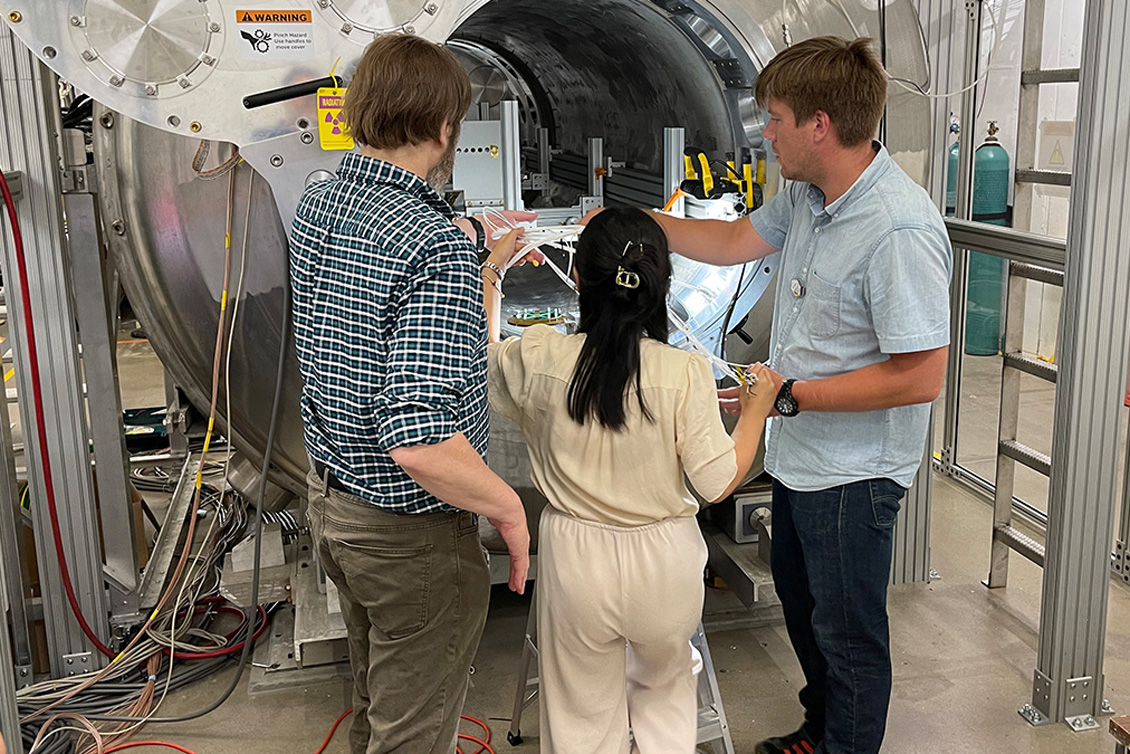FRIB/Argonne National Laboratory collaboration on SOLARIS instrument bears fruit

Share this article:
Share this article:
Using the SOLenoid Spectrometer Apparatus for ReactIon Studies (SOLARIS), a research team created a reaction that added a neutron to silicon-32—a long-lived isotope—creating silicon-33 and comparing the experimental results with shell model calculations. Ben Kay, experimental nuclear-structure physicist at Argonne National Laboratory (ANL), and Daniel Bazin, research professor at FRIB, led the team. The first findings from SOLARIS experiments have been published in Physics Letters B.
The team found that the structure of silicon-33, along with other nearby isotopes, is modified by the degree to which neutrons are bound by the nucleus—the weaker the binding, the closer together certain nuclear levels are to one another. Thesefindings contradict calculations done using relativistic mean-field theory, opening yet another research avenue researchers can investigate with the help of SOLARIS.
“This is an essential step forward—it is another piece of the puzzle we are trying to solve,” said Kay.
SOLARIS’s dual modes enable new exotic element investigations
Since the mid-twentieth century, researchers have investigated particle reactions by shooting lighter particle beams at thin targets made of heavier elements. The particle beam ejects or picks up particles from the target nuclei in distinct patterns, which researchers observe through a series of detectors after a beam transfers them from the target. While this method was effective in studying the several hundred stable isotopes known to scientists, since the 1990s, researchers have actively sought out methods for using heavier, radioactive ion beams to better understand exotic, short-lived particles’ properties under a variety of conditions.
However, if researchers want to use heavier radioactive elements in a beam and lighter elements as the target, this traditional instrument encounters problems. While physicists and engineers developed the technology to give accurate readings on earlier experiments, these instruments were only capturing a compressed version of the ejected particles’ distributions when using certain beams of heavier elements. Kay, Bazin, and their colleagues wanted to design tools that could help solve that problem.
Kay worked with ANL colleagues and external collaborators to develop and build the Helical Orbit Spectrometer (HELIOS), which was commissioned in 2010. The machine helps researchers study reactions in short-lived nuclei. HELIOS uses a solenoid—an electromagnet shaped into a coil that can create a specific magnetic field. When an accelerated beam hits its film target, the solenoid’s magnetic field moves the resulting reaction products backward (or forward) from the target position.
While ANL houses HELIOS, Bazin spearheaded the effort to build the active target time-projection chamber (AT-TPC) at FRIB. Like HELIOS, AT-TPC helps researchers study short-lived reactions of exotic particles in cases when the target’s nucleus is much lighter than the nucleus coming from a beam. While HELIOS focuses on recording particles’ behavior as they follow the electromagnetic field of a solenoid, AT-TPC uses gas as both a beam’s target as well as the detection medium.
In both cases, these tools helped researchers run experiments with heavier radioactive isotopes shot into lighter elements to collect ejected particles’ distributions.
“Physicists came to realize that when we put these detectors at static angles, these distributions we were studying get squished together, and we lose our resolving power,” Kay said. “Science in this context is all about clearly seeing peaks in a distribution plot, and if they are squished together or look to be overlapping, you don’t actually reveal the full structure.”
Both HELIOS and AT-TPC used different methods for detecting elements ejected during an experiment, and their complementary nature led to another innovation—if the team combined these two instruments into one, researchers could leverage both methods to capture a wider range of particle distributions.
Kay and Bazin joined forces in 2012 to develop the world’s first dual-mode spectrometer of its kind—SOLARIS. In 2020, the team rebuilt a version of HELIOS at FRIB and combined it with AT-TPC to create SOLARIS. Now, researchers can use either a silicon detector array or AT-TPC to study exotic particle reactions using reaccelerated beams. Kay, Bazin, and their team have conducted a host of experiments and created accurate distribution charts of ejected particles’ behavior using SOLARIS.
“SOLARIS is the result of a beautiful connection between two labs, each bringing an invaluable contribution to this device,” Kay said. “Both ANL and FRIB contributed technology and techniques that filled out the left and right sides of the bigger picture.”
Eric Gedenk is a freelance science writer.
Michigan State University (MSU) operates the Facility for Rare Isotope Beams (FRIB) as a user facility for the U.S. Department of Energy Office of Science (DOE-SC), with financial support from and furthering the mission of the DOE-SC Office of Nuclear Physics. Hosting the most powerful heavy-ion accelerator, FRIB enables scientists to make discoveries about the properties of rare isotopes in order to better understand the physics of nuclei, nuclear astrophysics, fundamental interactions, and applications for society, including in medicine, homeland security, and industry.
The U.S. Department of Energy Office of Science is the single largest supporter of basic research in the physical sciences in the United States and is working to address some of today’s most pressing challenges. For more information, visit energy.gov/science.

